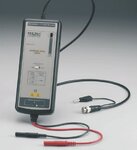abhishek.2138
Full Member level 2
I am working on 1 Kw AC drive project. The single phase AC motor speed is controlled by driving it through IGBT full bridge. Now, for designing the circuit some measurements are needed by Digital storage oscilloscope. The ground of DSO is connected to earth. The earth & neutral are short at the circuit breaker. When I connect this DSO ground in my circuit the fuse gets blown.
When I disconnect the earth connection to DSO the fuse doesn't blow, but the DSO probe has AC voltage shown by tester.
What should be done to avoid AC voltage at DSO probe???
Should I connect Isolation transformer at the DSO input (only phase & neutral of transformer secondary to DSO) & earth to be connected separately to DSO??
Please help...
When I disconnect the earth connection to DSO the fuse doesn't blow, but the DSO probe has AC voltage shown by tester.
What should be done to avoid AC voltage at DSO probe???
Should I connect Isolation transformer at the DSO input (only phase & neutral of transformer secondary to DSO) & earth to be connected separately to DSO??
Please help...
